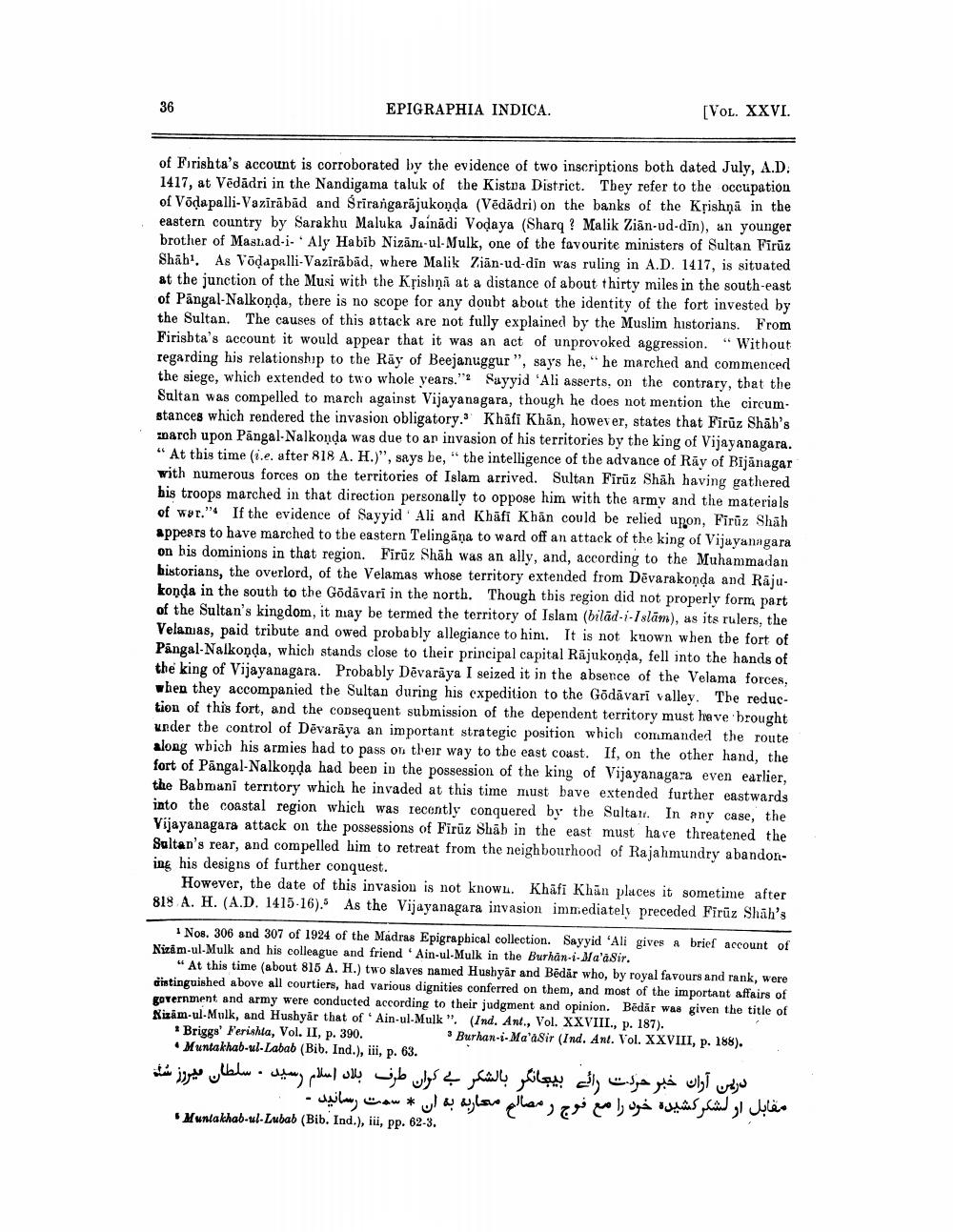________________
36
EPIGRAPHIA INDICA.
[VOL. XXVI.
of Forishta's account is corroborated by the evidence of two inscriptions both dated July, A.D. 1417, at Vedadri in the Nandigama taluk of the Kistna District. They refer to the occupation of Vöda palli-Vazirabad and Srirangarājukonda (Vēdädri) on the banks of the Krishna in the eastern country by Sarakhu Maluka Jainādi Vodaya (Sharq ? Malik Zian-ud-din), an younger brother of Masliad-i-Aly Habib Nizani-ul-Mulk, one of the favourite ministers of Sultan Firūz Shah'. As Vödapalli-Vazirābād, where Malik Zian-ud-din was ruling in A.D. 1417, is situated at the junction of the Musi with the Krishni at a distance of about thirty miles in the south-east of Pangal-Nalkonda, there is no scope for any doubt about the identity of the fort invested by the Sultan. The causes of this attack are not fully explained by the Muslim historians. From Firishta's account it would appear that it was an act of unprovoked aggression. "Without regarding his relationship to the Ray of Beejanuggur", says he," he marched and commenced the siege, which extended to two whole years."2 Sayyid 'Ali asserts, on the contrary, that the Sultan was compelled to march against Vijayanagara, though he does not mention the circumstances which rendered the invasion obligatory. Kháli Khan, however, states that Firüz Shāh's narch upon Pangal.Nalkonda was due to ar invasion of his territories by the king of Vijayanagara. "At this time (i.e. after 818 A. H.)", says be," the intelligence of the advance of Rāy of Bijanagar with numerous forces on the territories of Islam arrived. Sultan Firüz Shah having gathered bis troops marched in that direction personally to oppose him with the army and the materials of war." If the evidence of Sayyid Ali and Khāfi Khan could be relied upon, Firuz Shah appears to have marched to the eastern Telingāna to ward off an attack of the king of Vijayanagara on bis dominions in that region. Firüz Shāh was an ally, and, according to the Muhammadan historians, the overlord, of the Velamas whose territory extended from Dēvarakonda and Rājukonda in the south to the Godavari in the north. Though this region did not properly forma part of the Sultan's kingdom, it may be termed the territory of Islam (bilād-i-Islam), as its rulers, the Velanias, paid tribute and owed probably allegiance to him. It is not known when the fort of Pāngal-Nalkonda, which stands close to their principal capital Rājukonda, fell into the hands of the king of Vijayanagara. Probably Dēvarāya I seized it in the absence of the Velama forces, when they accompanied the Sultan during his expedition to the Godavari valley. The reduction of this fort, and the consequent submission of the dependent territory must have brought under the control of Dēvarāya an important strategic position which commanded the route along wbich his armies had to pass on their way to the east coast. If, on the other hand, the fort of Pāngal-Nalkonda had been in the possession of the king of Vijayanagara even earlier, the Babmani territory which he invaded at this time must bave extended further eastwards into the coastal region which was recently conquered by the Saltar. In any case, the Vijayanagara attack on the possessions of Firuz Shāh in the east must have threatened the Sultan's rear, and compelled him to retreat from the neighbourhood of Rajahmundry abandoning his designs of further conquest.
However, the date of this invasion is not knowu. Khafi Khan places it sometime after 818 A. H. (A.D. 1415-16). As the Vijayanagara invasion imn.ediately preceded Firüz Shah's
Nos. 306 and 307 of 1924 of the Madras Epigraphical collection. Sayyid 'Ali gives a brief account of Nizam-ul-Mulk and his colleague and friend 'Ain-ul-Mulk in the Burhan-i-Wa'asir.
" At this time (about 815 A. H.) two slaves named Hushyår and Bedår who, by royal favours and rank, were Gintinguished above all courtiers, had various dignities conferred on them, and most of the important affairs of government and army were conducted according to their judgment and opinion. Bēdar was given the title of Nizâm-ul-Mulk, and Hushyar that of 'Ain-ul-Mulk", (Ind. Ant., Vol. XXVIII., p. 187). * Briggs' Ferishta, Vol. II, p. 390.
Burhan-i-Ma'asir (Ind. Ant. Vol. XXVIII, p. 188). . Muntakhab-ul-Labab (Bib. Ind.), iii, p. 63.
بلاد اسلام رسید • سلطان فیروز شلة درین آران خبر حركت رائے بیانگر بالشکر بے کران طرف مقابل ار لشکر کشیده خود را مع فوج رمصالح معاربه به آن * سمت رسانید -
Muntakhab-ul-Lubab (Bib. Ind.), iii, pp. 62-3.




